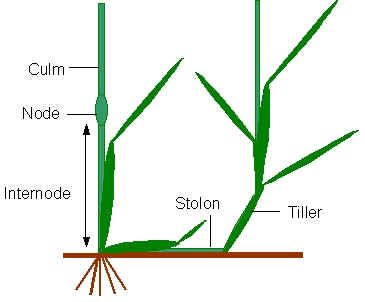 The roots are
fibrous |
Grass Stems
- are mostly hollow, cylindrical and interrupted at intervals by swollen joints
or nodes. Stems are rarely branched above the ground
and are called CULMS.
Some grasses have stems which creep along the surface of the ground
and give rise to new shoots (TILLERS) at their nodes. The horizontal stems are
called STOLONS.
If the horizontal stems go underground they
are called RHIZOMES.
Leaves - originate from the nodes. The lower portion of the
leaf forms a sheath, which encloses and protects the young shoots. The second half of the
leaf then opens out into the leaf blade. |
| . |
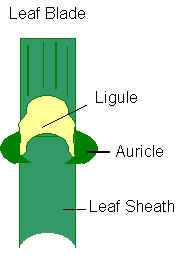
|
The leaf blade is usually
long and narrow, with parallel sides and veins and tapering to a pointed or blunt
tip. At the junction of the sheath and blade there is a
small membranous flap of tissue called the LIGULE (image
here). This is sometimes just a
fringe of hairs (image here).
In some grasses there are also
projections on either side of the ligule called AURICLES.
The structure and dimensions of the sheath, blade and
ligule, and their hairiness provide good diagnostic features for identification. |
|
| |
| The part of the grass plant popularly known as the flower, is actually
composed of many small flowers hidden, except at flowering time, within scales or bracts.
The structures containing the flowers are called SPIKELETS. |
| The Grass Flower |
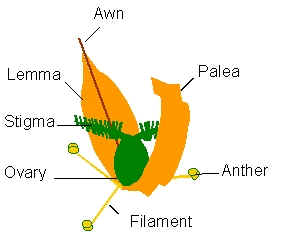 |
The flower
is usually bisexual. It consists of an ovary containing 1 ovule (the female part). The
ovary is usually surmounted by two feathery stigmas and is surrounded by three
stamens. Each stamen (the male part of the flower) consists of an anther (image here) and a filament. There are no petals or sepals.
Instead, the flower is protected by two sets of scales. The first set consists of
the LEMMA and the PALEA which enclose the flower. This whole structure is called a floret.
(More on the flower structure of Flowering Plants here) |
| . |
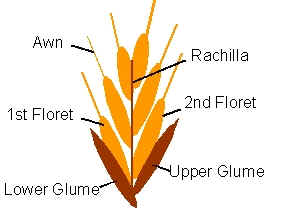 |
One or
more florets may be arranged on an axis (the RACHILLA), with all of the florets being
protected by a second set of scales at the base called GLUMES. The glumes enclose the
florets before they are mature.
The whole unit is called a SPIKELET(image here). The Lemmas (of individual florets) and/or the Glumes, may have bristle-like
extensions called AWNS arising from them.
(Left: a spikelet made up of 6 florets) |
| |
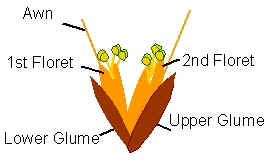
|
A
spikelet made up of 2 florets (image
here)
The spikelets are arranged into a
flowering head (inflorescence) in a number of different ways depending on species. |
|
|
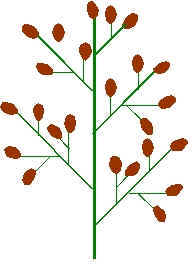
|
When the spikelets are borne on stalks on branches from the main
axis, the flower-head is called a PANICLE (image here).
(In this diagram of a Panicle, the
spikelets are depicted as brown ovals) |
. |

|
If the spikelets are stalked directly on the main axis, then the
flower-head is a RACEME. |
. |

|
Where there are no stalks, and the spikelets are seated on the main axis
itself, the flower-head or ear is known as a SPIKE (image here). |
|
Continue to
Ten top tips for identifying grasses
|